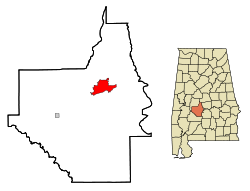Selma, Alabama
| Selma, Alabama | |
|---|---|
| City | |

The St. James Hotel and a portion of Water Avenue in Selma
|
|
| Nickname(s): Queen City of the Black Belt, Butterfly Capital of Alabama | |
 Location in Dallas County and the state of Alabama |
|
| Coordinates: 32°24′59″N 87°1′29″W / 32.41639°N 87.02472°WCoordinates: 32°24′59″N 87°1′29″W / 32.41639°N 87.02472°W | |
| Country | United States |
| State | Alabama |
| County | Dallas |
| Settled | 1815 |
| Incorporated | 1820 |
| Government | |
| • Type | Mayor/City Council |
| • Mayor | Darrio Melton (D) |
| Area | |
| • Total | 14.5 sq mi (37.4 km2) |
| • Land | 13.9 sq mi (35.9 km2) |
| • Water | 0.6 sq mi (1.5 km2) |
| Elevation | 125 ft (38 m) |
| Population (2014) | |
| • Total | 19,814 |
| • Density | 1,503.1/sq mi (548.4/km2) |
| Time zone | Central (CST) (UTC-6) |
| • Summer (DST) | CDT (UTC-5) |
| ZIP codes | 36701-36703 |
| Area code(s) | 334 (Exchanges: 418, 872, 874, 875, 876, 877, 878) |
| FIPS code | 01-69120 |
| GNIS feature ID | 0163940 |
| Website | www |
Selma is a city in and the county seat of Dallas County, in the Black Belt region of south central Alabama and extending to the west. Located on the banks of the Alabama River, the city has a population of 20,756 as of the 2010 census.
The city is best known for the 1960s Selma Voting Rights Movement and the Selma to Montgomery marches, beginning with "Bloody Sunday" in March 1965 and ending with 25,000 people entering Montgomery at the end of the last march to press for voting rights. This activism generated national attention to social justice and that summer, the Voting Rights Act of 1965 was passed by Congress to authorize federal oversight and enforcement of constitutional rights of all citizens.
It had been a trading center and market town during the years of King Cotton in the South. It was also an important armaments manufacturing and iron shipbuilding center during the Civil War, surrounded by miles of earthen fortifications. The undermanned Confederate forces were defeated during the Battle of Selma.
Before settlement by European peoples, the area of present-day Selma had been inhabited for thousands of years by varying cultures of indigenous peoples. The Europeans encountered the historic Native American people known as the Muscogee (also known as the Creek), who had been in the area for hundreds of years.
French explorers and colonists were the first Europeans to explore this area. In 1732, they recorded the site of present-day Selma as Écor Bienville. Later Anglo-Americans called it the Moore's Bluff settlement. Selma was incorporated in 1820. The city was planned and named as Selma by William R. King, a politician and planter from North Carolina who was a future Vice President of the United States. The name, meaning "high seat" or "throne", came from the Ossianic poem The Songs of Selma.
...
Wikipedia
